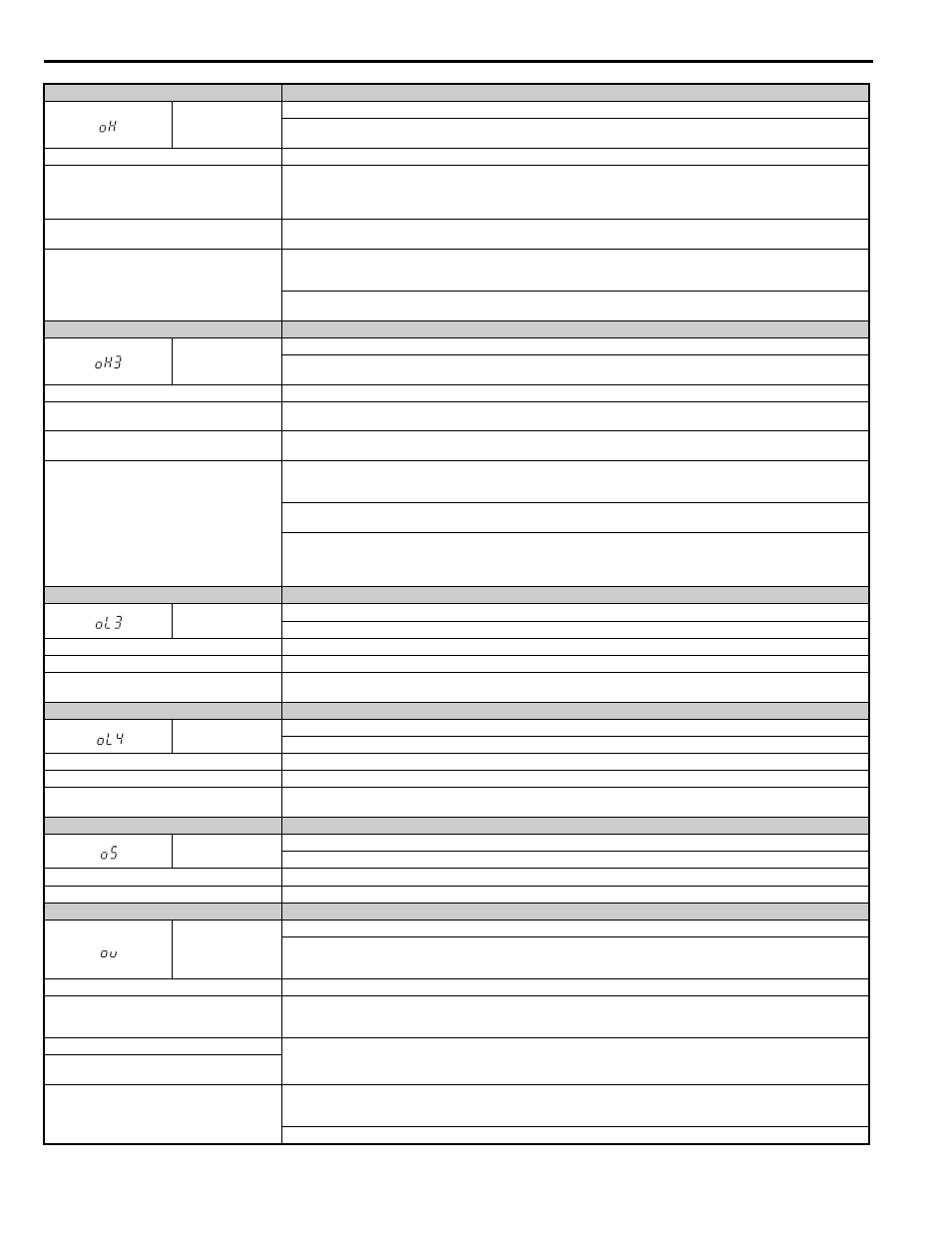4 alarm detection – Yaskawa L1000E AC Drive Technical Manual for CIMR-LE Models for Elevator Applications User Manual
Page 292

6.4 Alarm Detection
292
YASKAWA ELECTRIC SIEP YAIL1E 01A YASKAWA AC Drive L1000E Technical Manual
Digital Operator Display
Minor Fault Name
oH
Heatsink Overheat
The temperature of the heatsink exceeded the overheat pre-alarm level set to L8-02 (90-100
°C). Default value for L8-02 is
determined by drive capacity (o2-04).
Cause
Possible Solutions
Surrounding temperature is too high
• Check the surrounding temperature.
• Improve the air circulation within the enclosure panel.
• Install a fan or air conditioner to cool surrounding area.
• Remove anything near drive that may cause extra heat.
Internal cooling fan has stopped.
• Replace the cooling fan.
Refer to Cooling Fan Component Names on page 316
• After replacing the drive, reset the cooling fan maintenance parameter to (o4-03 = “0”).
Airflow around the drive is restricted.
• Provide proper installation space around the drive as indicated in the manual.
Refer to Installation Orientation and Spacing on
.
• Allow for the specified space and ensure that there is sufficient circulation around the control panel.
• Check for dust or foreign materials clogging cooling fan.
• Clear debris caught in the fan that restricts air circulation.
Digital Operator Display
Fault Name
oH3
Motor Overheat Alarm (PTC thermistor input)
• The motor overheat signal to analog input terminal A1 or A2 exceeded the alarm detection level.
• Detection requires multi-function analog input H3-02 or H3-10 be set to “E”.
Cause
Possible Solution
Motor thermostat wiring is fault (PTC thermistor
input).
Repair the PTC thermistor input wiring.
There is a fault on the machine side (e.g., the
machine is locked up).
• Check the status of the machine.
• Remove the cause of the fault.
Motor has overheated
• Check the status of the machine.
• Decrease the load.
• Increase the acceleration and deceleration times (C1-01 through C1-08).
• Adjust the preset V/f pattern (E1-04 through E1-10). This will mainly involve reducing E1-08 and E1-10.
• Be careful not to lower E1-08 and E1-10 too much, as this reduces load tolerance at low speeds.
• Check the motor rated current.
• Enter the motor rated current as indicated on the motor nameplate (E2-01).
• Ensure the motor cooling system is operating normally.
• Repair or replace the motor cooling system.
Digital Operator Display
Minor Fault Name
oL3
Overtorque Detection 1
Drive output current (or torque in OLV, CLV, CLV/PM) was greater than L6-02 for longer than the time set in L6-03.
Cause
Possible Solutions
Inappropriate parameter settings.
Check parameters L6-02 and L6-03.
There is a fault on the machine side (e.g., the
machine is locked up).
• Check the status of the machine.
• Remove the cause of the fault.
Digital Operator Display
Minor Fault Name
oL4
Overtorque Detection 2
Drive output current (or torque in OLV, CLV, CLV/PM) was greater than L6-05 for longer than the time set in L6-06.
Cause
Possible Solutions
Parameter settings are not appropriate.
Check parameters L6-05 and L6-06.
There is a fault on the machine side (e.g., the
machine is locked up).
• Check the status of the machine being used.
• Remove the cause of the fault.
Digital Operator Display
Minor Fault Name
oS
Overspeed (for Control Mode with Encoder)
The motor speed feedback exceeded the F1-08 setting.
Cause
Possible Solutions
Inappropriate parameter settings.
Check the setting for the overspeed detection level and the overspeed detection time (F1-08 and F1-09).
Digital Operator Display
Minor Fault Name
ov
DC Bus Overvoltage
The DC bus voltage exceeded the trip point.
For 200 V class: approximately 410 V
For 400 V class: approximately 820 V
Cause
Possible Solutions
Surge voltage present in the drive input power.
• Install a DC link choke or an AC reactor.
• Voltage surge can result from a thyristor convertor and a phase advancing capacitor operating on the same drive input power
system.
The motor is short-circuited.
• Check the motor power cable, relay terminals and motor terminal box for short circuits.
• Correct grounding shorts and turn the power back on.
Ground current has over-charged the main circuit
capacitors via the drive input power.
Noise interference causes the drive to operate
incorrectly.
• Review possible solutions for handling noise interference.
• Review section on handling noise interference and check control circuit lines, main circuit lines and ground wiring.
• If the magnetic contactor is identified as a source of noise, install a surge protector to the MC coil.
Set number of fault reset (L5-01) to a value other than 0.